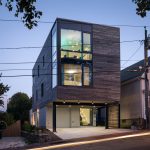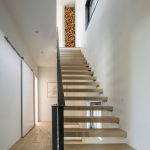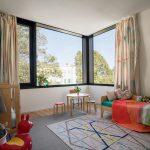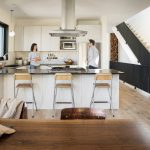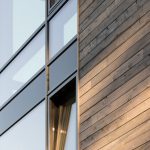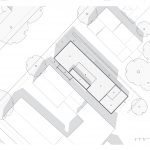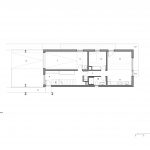Boxed In(fill)
Project Name
On a small site in a transitional neighborhood, a single family residence inverts the typical program stack elevating living spaces to the top floor to capture views of the bay and to provide access to outdoor space on the roof. Boxed In(fill) is a bold, elegant, and efficient custom home in Portland, Maine’s Munjoy Hill neighborhood. A modernist reinterpretation of themes found in its nineteenth-century neighbors, the building reflects a close collaboration between OPAL and our clients, who played a key role in the design process. The resulting project—on a tightly regulated infill lot of less than 3,000 square feet—deftly orchestrates parking, privacy, views, and interior space to create a high-performance platform for contemporary urban living.
Our design draws on the time-honored town house model, with a side staircase and rooms arranged in linear fashion from front to rear. Breaking with neighborhood precedent, though, we elevated the two-story main residence above street level for privacy and views, devoting the ground floor to a single-car garage and an efficient one-bedroom apartment. We offset the stucco-clad lower volume toward the rear, creating an elevated deck at the back of the building and sheltered parking for two additional cars at the front. An operable wood screen encloses one bay of the car port, matching the plane of the neighboring facades at pedestrian level.
Stacked atop this base is the boxlike volume of the main residence, whose stained cedar siding peels back from the northeast corner to expose a two-story, wood-framed curtain wall. The views improve as one ascends in the building, so we located the main residence’s three bedrooms at the second floor, reserving the third floor for the kitchen, dining, and living spaces. From a glazed corner entry vestibule at the ground floor, the main stair rises through three levels, culminating at a rooftop deck with views over neighboring buildings to Portland Harbor and the islands of Casco Bay.
The building’s interiors are clean and open, with minimal trim. The clients led the material-selection process, developing a sophisticated white-to-gray color palette accented by black window sashes and a distinctive black steel stair railing. Windows—triple-glazed for energy efficiency—are strategically located to provide views, natural lighting, solar gain, and privacy from the surrounding buildings. The building shell, which consists of a heavily insulated, air-sealed wood frame enveloped in a continuous layer of rigid insulation, delivers energy performance that approaches the Passive House standard.
Measure 1: Design for Integration
Boxed In(fill) achieves integration with its low-rise urban setting by following neighborhood conventions of building height, massing, and street setback. Coping with stringent regulatory constraints, the building contains two dwelling units—increasing the density of its site—provides valuable off-street parking, and takes full advantage of available natural light and views. Its fresh-yet-compatible take on a local building type enhances life on the block for both the occupants and their neighbors.
Measure 2: Design for Community
The permitting and design process involved extensive collaboration with the owners, municipal agencies, and interested neighbors. The resulting building supports the local built environment and culture, which promote an active, engage street life. With its direct engagement with the street, the building takes full advantage of the walkable environment and the convenience of public transportation.
Measure 3: Design for Ecology
Due to the nature of the site and the density of development, limited potential existed for ecosystem restoration.
Measure 4: Design for Water
The project makes use of water-conserving plumbing fixtures. A new rain garden helps manage stormwater on the site.
Measure 5: Design for Economy
The project maximizes cost performance by making efficient use of space—providing two living units on a 3,000 square foot lot—and incorporating durable, low-maintenance materials. A high performance building shell, including high levels of thermal insulation and triple-glazed windows and doors, reduces annual energy cost by approximately 80 percent, compared with conventional, code-compliant construction.
Measure 6: Design for Energy
Our energy strategy incorporated building design to optimize passive solar gain within the constraints of the site; an air-sealed, near-Passive House building shell; an energy efficient HRV system; a high-efficiency, sealed-combustion wood-burning stove; and high-efficiency lighting and mechanical systems. Electric heat pumps supply supplemental heating and cooling.
Measure 7: Design for Wellness
The high performance building shell maintains a stable and uniform temperature with minimal supplemental heating, providing a high degree of thermal comfort. Continuous, tempered, filtered ventilation maximizes indoor air quality. Fenestration provides ample, balanced daylighting, while minimizing harsh, low-angle sunlight. Materials and finishes were selected, to the greatest degree possible, to minimize VOC content throughout. The house’s location and configuration encourage walking and cycling as part of daily life. A bright, quiet interior with views over the city, Portland Harbor, and Casco bay—along with two private outdoor decks—provides a healthy respite from a busy urban environment.
Measure 8: Design for Resources
The white cedar siding is a sustainably produced local product that requires no finish over its lifespan. The building makes use of cellulose insulation manufactured from recycled paper. The aluminum-clad windows and doors are prefinished and require no exterior finish maintenance.
Measure 9: Design for Change
The building’s two apartments—a one-bedroom unit at ground level, and a two-bedroom unit above—provide the owners with a variety of future-use scenarios, including short- and long-term rental options, caring for an elderly family member, and aging in place.
Measure 10: Design for Discovery
Applying Passive House principles to an infill project on a tight, urban site required that we address challenges related to orientation, access, and views, and privacy. We managed the critical relationship between public and private realms by means of the building section, locating the accessory unit at street level, toward the rear of the building, and stacking the primary residence above.

